
Rabbit Anti-Adiponectin antibody
30 kDa adipocyte complement related protein; 30 kDa adipocyte complement-related protein; ACDC; ACRP 30; ACRP30; ADIPO_HUMAN; Adipocyte; Adipocyte C1q and collagen domain containing protein; Adipocyte complement related 30 kDa protein; Adipocyte complemen
View History [Clear]
Details
Product Name Adiponectin Chinese Name 脂联素抗体 Alias 30 kDa adipocyte complement related protein; 30 kDa adipocyte complement-related protein; ACDC; ACRP 30; ACRP30; ADIPO_HUMAN; Adipocyte; Adipocyte C1q and collagen domain containing protein; Adipocyte complement related 30 kDa protein; Adipocyte complement related protein of 30 kDa; Adipocyte complement-related 30 kDa protein; Adiponectin; AdipoQ; Adipose most abundant gene transcript 1; Adipose most abundant gene transcript 1 protein; Adipose specific collagen like factor; ADIPQTL1; ADPN; APM 1; apM-1; ApM1; C1q and collagen domain-containing protein; GBP 28; GBP28; Gelatin binding protein; Gelatin binding protein 28; Gelatin-binding protein. literatures Research Area immunology Diabetes Endocrinopathy Immunogen Species Rabbit Clonality Polyclonal React Species Human, Mouse, Rat, (predicted: Chicken, Dog, Pig, Cow, Rabbit, ) Applications WB=1:500-2000 ELISA=1:5000-10000 IHC-P=1:100-500 IHC-F=1:100-500 IF=1:100-500 (Paraffin sections need antigen repair)
not yet tested in other applications.
optimal dilutions/concentrations should be determined by the end user.Theoretical molecular weight 25kDa Cellular localization Secretory protein Form Liquid Concentration 1mg/ml immunogen KLH conjugated synthetic peptide derived from human Adiponectin: 151-244/244 Lsotype IgG Purification affinity purified by Protein A Buffer Solution 0.01M TBS(pH7.4) with 1% BSA, 0.03% Proclin300 and 50% Glycerol. Storage Shipped at 4℃. Store at -20 °C for one year. Avoid repeated freeze/thaw cycles. Attention This product as supplied is intended for research use only, not for use in human, therapeutic or diagnostic applications. PubMed PubMed Product Detail Adiponectin: A protein hormone produced and secreted exclusively by adipocytes (fat cells) that regulates the metabolism of lipids and glucose. Adiponectin influences the body's response to insulin. Adiponectin also has antiinflammatory effects on the cells lining the walls of blood vessels. High blood levels of adiponectin are associated with a reduced risk of heart attack. Low levels of adiponectin are found in people who are obese (and who are at increased risk of a heart attack). Adipocytes produce and secrete a number of proteins, including leptin, adipsin, properdin, and tumor necrosis factor (TNF). An adipose tissue-specific factor was isolated and termed APM1 (AdiPose Most abundant gene transcript 1). The protein product of APM1 is adiponectin. The APM1 gene maps to chromosome 3q27.
Function:
Important adipokine involved in the control of fat metabolism and insulin sensitivity, with direct anti-diabetic, anti-atherogenic and anti-inflammatory activities. Stimulates AMPK phosphorylation and activation in the liver and the skeletal muscle, enhancing glucose utilization and fatty-acid combustion. Antagonizes TNF-alpha by negatively regulating its expression in various tissues such as liver and macrophages, and also by counteracting its effects. Inhibits endothelial NF-kappa-B signaling through a cAMP-dependent pathway. May play a role in cell growth, angiogenesis and tissue remodeling by binding and sequestering various growth factors with distinct binding affinities, depending on the type of complex, LMW, MMW or HMW.
Subunit:
Homomultimer. Forms trimers, hexamers and 12- to 18-mers. The trimers (low molecular weight complexes / LMW) are assembled via non-covalent interactions of the collagen-like domains in a triple helix and hydrophobic interactions within the globular C1q domain. Several trimers can associate to form disulfide-linked hexamers (middle molecular weight complexes / MMW) and larger complexes (higher molecular weight / HMW). The HMW-complex assembly may rely aditionally on lysine hydroxylation and glycosylation. LMW, MMW and HMW complexes bind to HBEGF, MMW and HMW complexes bind to PDGFB, and HMW complex binds to FGF2. Interacts with CTRP9A via the C1q domain (heterotrimeric complex).
Subcellular Location:
Secreted.
Tissue Specificity:
Synthesized exclusively by adipocytes and secreted into plasma.
Post-translational modifications:
Hydroxylated Lys-33 was not identified in PubMed:16497731, probably due to poor representation of the N-terminal peptide in mass fingerprinting.
HMW complexes are more extensively glycosylated than smaller oligomers. Hydroxylation and glycosylation of the lysine residues within the collagene-like domain of adiponectin seem to be critically involved in regulating the formation and/or secretion of HMW complexes and consequently contribute to the insulin-sensitizing activity of adiponectin in hepatocytes (By similarity).
O-glycosylated. Not N-glycosylated. O-linked glycans on hydroxylysines consist of Glc-Gal disaccharides bound to the oxygen atom of post-translationally added hydroxyl groups. Sialylated to varying degrees depending on tissue. Thr-22 appears to be the major site of sialylation. Higher sialylation found in SGBS adipocytes than in HEK fibroblasts. Sialylation is not required neither for heterodimerization nor for secretion. Not sialylated on the glycosylated hydroxylysines. Desialylated forms are rapidly cleared from the circulation.
DISEASE:
Adiponectin deficiency (ADPND) [MIM:612556]: A condition that results in very low concentrations of plasma adiponectin. Note=The disease is caused by mutations affecting the gene represented in this entry.
Diabetes mellitus, non-insulin-dependent (NIDDM) [MIM:125853]: A multifactorial disorder of glucose homeostasis caused by a lack of sensitivity to the body's own insulin. Affected individuals usually have an obese body habitus and manifestations of a metabolic syndrome characterized by diabetes, insulin resistance, hypertension and hypertriglyceridemia. The disease results in long-term complications that affect the eyes, kidneys, nerves, and blood vessels. Note=Disease susceptibility is associated with variations affecting the gene represented in this entry.
Similarity:
Contains 1 C1q domain.
Contains 1 collagen-like domain.
SWISS:
Q15848
Gene ID:
9370
Database links:Entrez Gene: 9370 Human
Entrez Gene: 11450 Mouse
Omim: 605441 Human
SwissProt: Q15848 Human
SwissProt: Q60994 Mouse
Unigene: 80485 Human
Unigene: 3969 Mouse
脂联素又被称作Acrp30、apM1、AdipoQ、GBP28。
最初, 脂联素是在人体皮下脂肪组织、血浆和鼠科动物的脂肪细胞中被发现人体内的脂联素由244个氨基酸组成,分子量为27KD。
脂联素影响脂肪和糖类的代谢,还可以降低多种粘附分子(VCAM-1、ICAM-1、选择素-E) 在endothelial cells的表达。并影响着Tumour坏死因子(TNF)分泌,近年来主要用于Diabetes的研究。
脂联素作为一种胰岛素超敏化激素(An Insulin–sensitizing Hormone),可以增加促进骨骼肌细胞的脂肪酸氧化和糖吸收,明显加强胰岛素的糖元异生作用,抑制肝脏的糖生成,是机体的脂质代谢和血糖稳态的调控网络中的重要调节因子,在脂肪细胞分泌的具有生物活性的一类蛋白质因子中脂联素是脂肪组织基因表达最丰富的蛋白质产物之一,大量存在于血液循环中。在人体内以3-30ug/ml的浓度出现在循环血浆中。Product Picture
Primary: Anti- Adiponectin (SL0471R) at 1/300 dilution
Secondary: HRP conjugated Goat-Anti-rabbit IgG (SL0295G-HRP) at 1/5000 dilution
Predicted band size: 25 kD
Observed band size: 27 kD
Sample:
Liver (Rat) Lysate at 40 ug
Intestine (Mouse) Lysate at 40 ug
Primary: Anti- Adiponectin (SL0471R) at 1/300 dilution
Secondary: HRP conjugated Goat-Anti-rabbit IgG (SL0295G-HRP) at 1/5000 dilution
Predicted band size: 25 kD
Observed band size: 25 kD
Sample:
Lane 1: Mouse Breast tissue lysates
Lane 2: Rat Breast tissue lysates
Primary: Anti-Adiponectin (SL0471R) at 1/1000 dilution
Secondary: IRDye800CW Goat Anti-Rabbit IgG at 1/20000 dilution
Predicted band size: 25 kD
Observed band size: 36 kD
Sample:
muscle (Mouse) Lysate at 40 ug
Primary: Anti-Adiponectin (SL0471R) at 1/300 dilution
Secondary: IRDye800CW Goat Anti-Rabbit IgG at 1/20000 dilution
Predicted band size: 30 kD
Observed band size: 30 kD
Tissue/cell: mouse liver tissue; 4% Paraformaldehyde-fixed and paraffin-embedded;
Antigen retrieval: citrate buffer ( 0.01M, pH 6.0 ), Boiling bathing for 15min; Block endogenous peroxidase by 3% Hydrogen peroxide for 30min; Blocking buffer (normal goat serum,C-0005) at 37℃ for 20 min;
Incubation: Anti-Adiponectin Polyclonal Antibody, Unconjugated(SL0471R) 1:200, overnight at 4°C, followed by conjugation to the secondary antibody(SP-0023) and DAB(C-0010) staining
Tissue/cell: human colon carcinoma; 4% Paraformaldehyde-fixed and paraffin-embedded;
Antigen retrieval: citrate buffer ( 0.01M, pH 6.0 ), Boiling bathing for 15min; Block endogenous peroxidase by 3% Hydrogen peroxide for 30min; Blocking buffer (normal goat serum,C-0005) at 37℃ for 20 min;
Incubation: Anti-Adiponectin Polyclonal Antibody, Unconjugated(SL0471R) 1:200, overnight at 4°C, followed by conjugation to the secondary antibody(SP-0023) and DAB(C-0010) staining
Bought notes(bought amounts latest0)
No one bought this product
User Comment(Total0User Comment Num)
- No comment
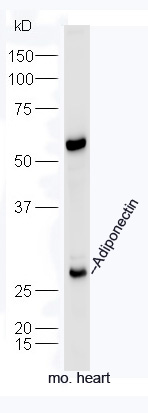
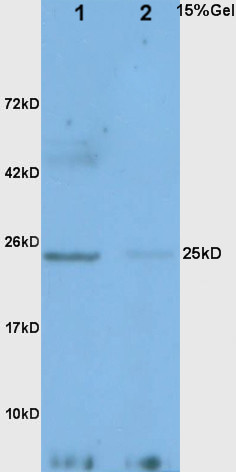
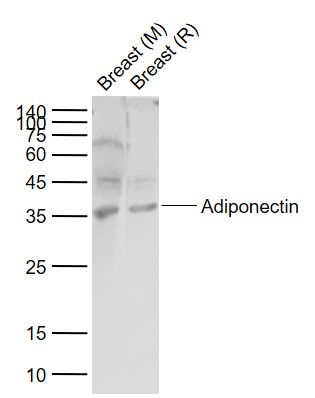
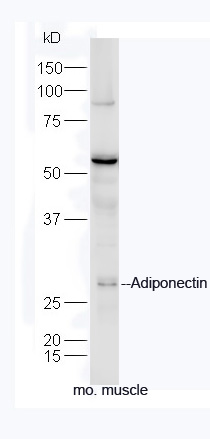
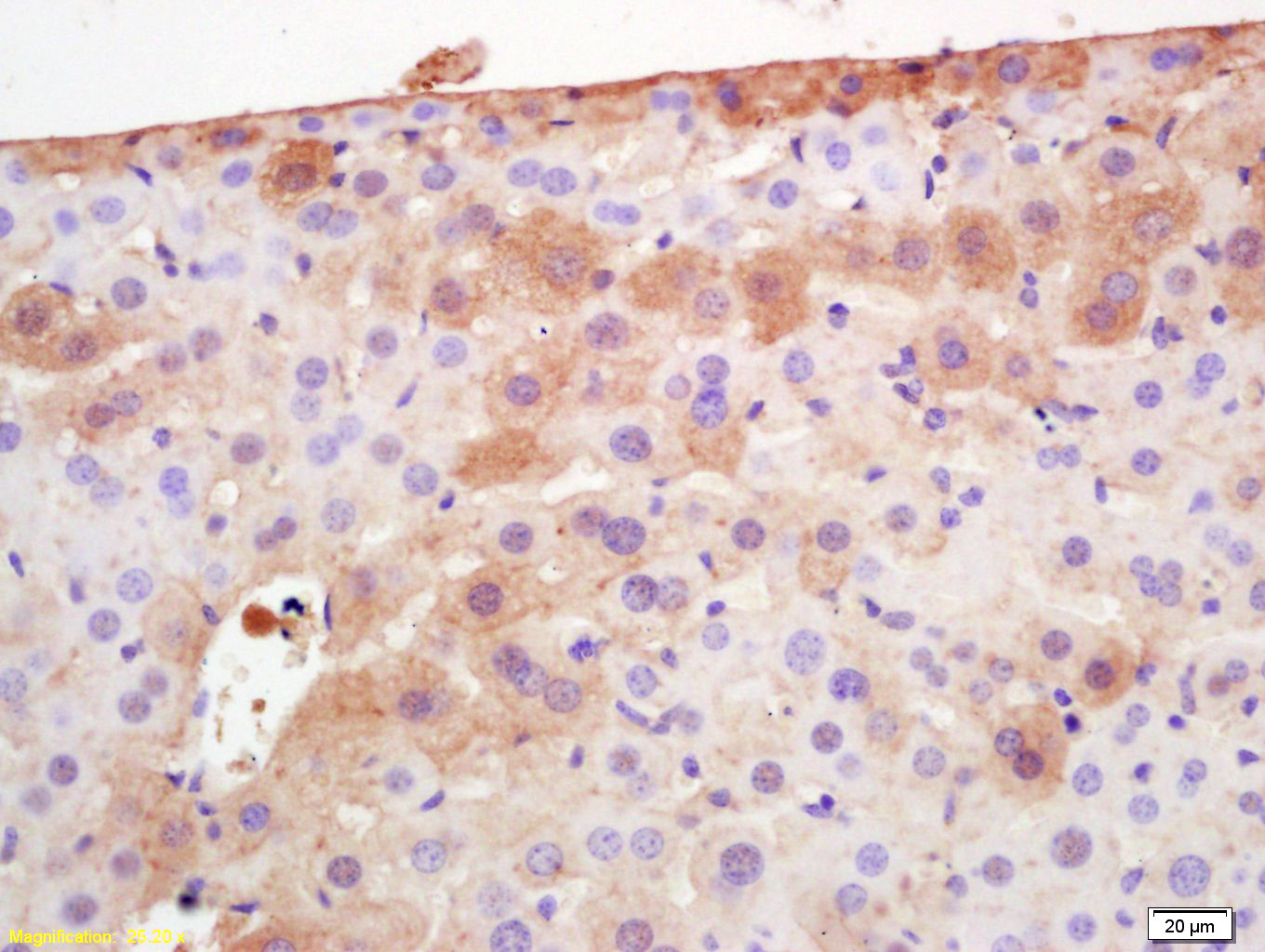
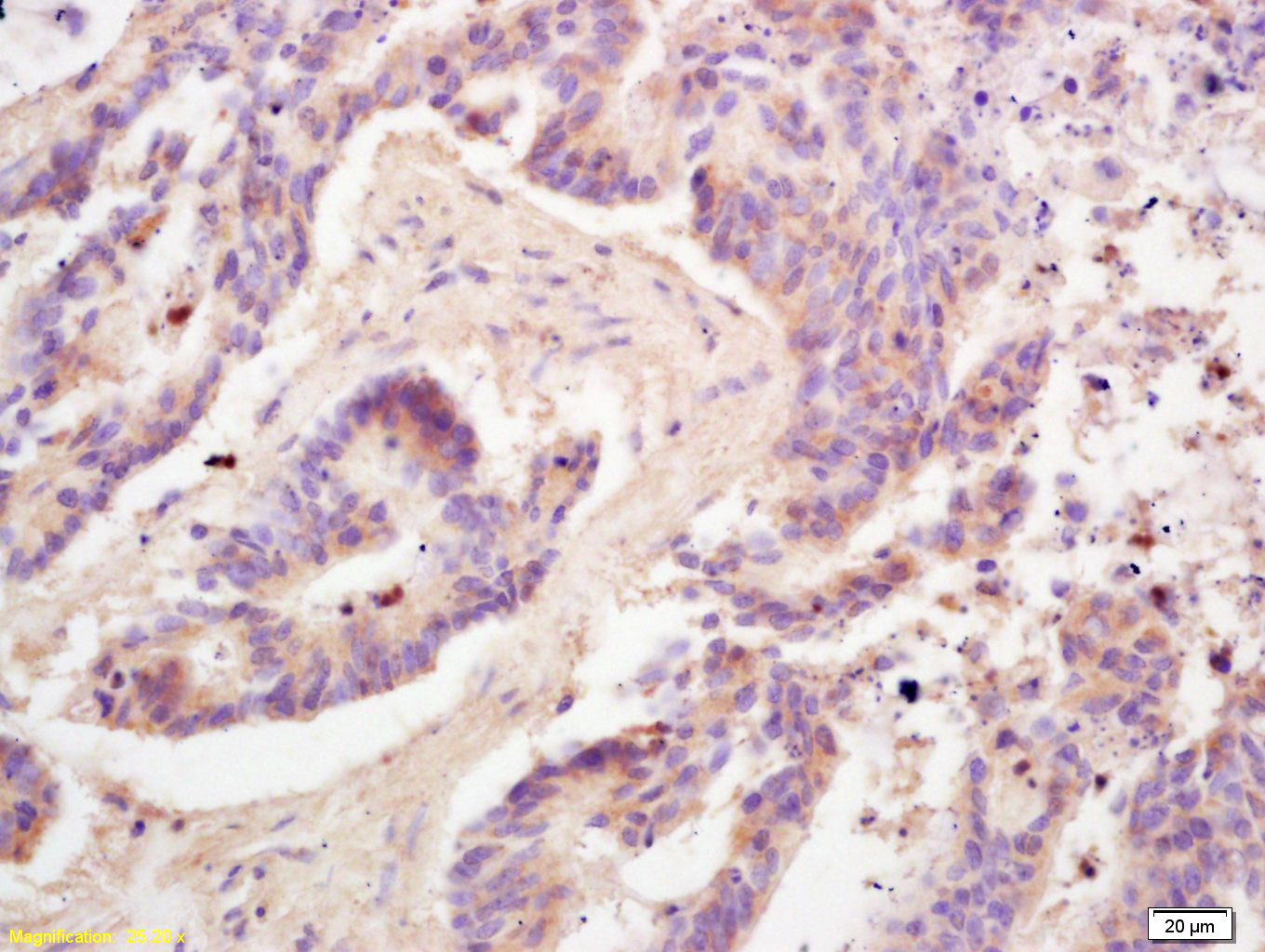


 +86 571 56623320
+86 571 56623320
 +86 18668110335
+86 18668110335

